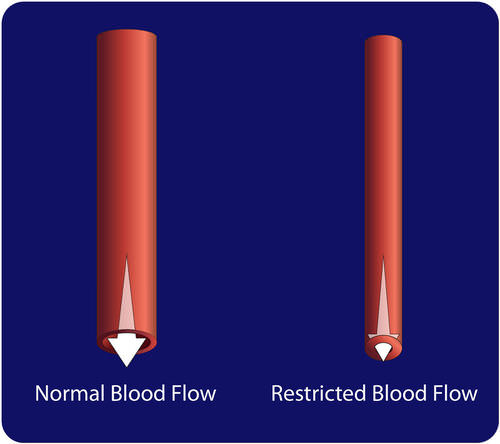13.17: Blood Vessels
- Page ID
- 13293
\( \newcommand{\vecs}[1]{\overset { \scriptstyle \rightharpoonup} {\mathbf{#1}} } \)
\( \newcommand{\vecd}[1]{\overset{-\!-\!\rightharpoonup}{\vphantom{a}\smash {#1}}} \)
\( \newcommand{\dsum}{\displaystyle\sum\limits} \)
\( \newcommand{\dint}{\displaystyle\int\limits} \)
\( \newcommand{\dlim}{\displaystyle\lim\limits} \)
\( \newcommand{\id}{\mathrm{id}}\) \( \newcommand{\Span}{\mathrm{span}}\)
( \newcommand{\kernel}{\mathrm{null}\,}\) \( \newcommand{\range}{\mathrm{range}\,}\)
\( \newcommand{\RealPart}{\mathrm{Re}}\) \( \newcommand{\ImaginaryPart}{\mathrm{Im}}\)
\( \newcommand{\Argument}{\mathrm{Arg}}\) \( \newcommand{\norm}[1]{\| #1 \|}\)
\( \newcommand{\inner}[2]{\langle #1, #2 \rangle}\)
\( \newcommand{\Span}{\mathrm{span}}\)
\( \newcommand{\id}{\mathrm{id}}\)
\( \newcommand{\Span}{\mathrm{span}}\)
\( \newcommand{\kernel}{\mathrm{null}\,}\)
\( \newcommand{\range}{\mathrm{range}\,}\)
\( \newcommand{\RealPart}{\mathrm{Re}}\)
\( \newcommand{\ImaginaryPart}{\mathrm{Im}}\)
\( \newcommand{\Argument}{\mathrm{Arg}}\)
\( \newcommand{\norm}[1]{\| #1 \|}\)
\( \newcommand{\inner}[2]{\langle #1, #2 \rangle}\)
\( \newcommand{\Span}{\mathrm{span}}\) \( \newcommand{\AA}{\unicode[.8,0]{x212B}}\)
\( \newcommand{\vectorA}[1]{\vec{#1}} % arrow\)
\( \newcommand{\vectorAt}[1]{\vec{\text{#1}}} % arrow\)
\( \newcommand{\vectorB}[1]{\overset { \scriptstyle \rightharpoonup} {\mathbf{#1}} } \)
\( \newcommand{\vectorC}[1]{\textbf{#1}} \)
\( \newcommand{\vectorD}[1]{\overrightarrow{#1}} \)
\( \newcommand{\vectorDt}[1]{\overrightarrow{\text{#1}}} \)
\( \newcommand{\vectE}[1]{\overset{-\!-\!\rightharpoonup}{\vphantom{a}\smash{\mathbf {#1}}}} \)
\( \newcommand{\vecs}[1]{\overset { \scriptstyle \rightharpoonup} {\mathbf{#1}} } \)
\( \newcommand{\vecd}[1]{\overset{-\!-\!\rightharpoonup}{\vphantom{a}\smash {#1}}} \)
\(\newcommand{\avec}{\mathbf a}\) \(\newcommand{\bvec}{\mathbf b}\) \(\newcommand{\cvec}{\mathbf c}\) \(\newcommand{\dvec}{\mathbf d}\) \(\newcommand{\dtil}{\widetilde{\mathbf d}}\) \(\newcommand{\evec}{\mathbf e}\) \(\newcommand{\fvec}{\mathbf f}\) \(\newcommand{\nvec}{\mathbf n}\) \(\newcommand{\pvec}{\mathbf p}\) \(\newcommand{\qvec}{\mathbf q}\) \(\newcommand{\svec}{\mathbf s}\) \(\newcommand{\tvec}{\mathbf t}\) \(\newcommand{\uvec}{\mathbf u}\) \(\newcommand{\vvec}{\mathbf v}\) \(\newcommand{\wvec}{\mathbf w}\) \(\newcommand{\xvec}{\mathbf x}\) \(\newcommand{\yvec}{\mathbf y}\) \(\newcommand{\zvec}{\mathbf z}\) \(\newcommand{\rvec}{\mathbf r}\) \(\newcommand{\mvec}{\mathbf m}\) \(\newcommand{\zerovec}{\mathbf 0}\) \(\newcommand{\onevec}{\mathbf 1}\) \(\newcommand{\real}{\mathbb R}\) \(\newcommand{\twovec}[2]{\left[\begin{array}{r}#1 \\ #2 \end{array}\right]}\) \(\newcommand{\ctwovec}[2]{\left[\begin{array}{c}#1 \\ #2 \end{array}\right]}\) \(\newcommand{\threevec}[3]{\left[\begin{array}{r}#1 \\ #2 \\ #3 \end{array}\right]}\) \(\newcommand{\cthreevec}[3]{\left[\begin{array}{c}#1 \\ #2 \\ #3 \end{array}\right]}\) \(\newcommand{\fourvec}[4]{\left[\begin{array}{r}#1 \\ #2 \\ #3 \\ #4 \end{array}\right]}\) \(\newcommand{\cfourvec}[4]{\left[\begin{array}{c}#1 \\ #2 \\ #3 \\ #4 \end{array}\right]}\) \(\newcommand{\fivevec}[5]{\left[\begin{array}{r}#1 \\ #2 \\ #3 \\ #4 \\ #5 \\ \end{array}\right]}\) \(\newcommand{\cfivevec}[5]{\left[\begin{array}{c}#1 \\ #2 \\ #3 \\ #4 \\ #5 \\ \end{array}\right]}\) \(\newcommand{\mattwo}[4]{\left[\begin{array}{rr}#1 \amp #2 \\ #3 \amp #4 \\ \end{array}\right]}\) \(\newcommand{\laspan}[1]{\text{Span}\{#1\}}\) \(\newcommand{\bcal}{\cal B}\) \(\newcommand{\ccal}{\cal C}\) \(\newcommand{\scal}{\cal S}\) \(\newcommand{\wcal}{\cal W}\) \(\newcommand{\ecal}{\cal E}\) \(\newcommand{\coords}[2]{\left\{#1\right\}_{#2}}\) \(\newcommand{\gray}[1]{\color{gray}{#1}}\) \(\newcommand{\lgray}[1]{\color{lightgray}{#1}}\) \(\newcommand{\rank}{\operatorname{rank}}\) \(\newcommand{\row}{\text{Row}}\) \(\newcommand{\col}{\text{Col}}\) \(\renewcommand{\row}{\text{Row}}\) \(\newcommand{\nul}{\text{Nul}}\) \(\newcommand{\var}{\text{Var}}\) \(\newcommand{\corr}{\text{corr}}\) \(\newcommand{\len}[1]{\left|#1\right|}\) \(\newcommand{\bbar}{\overline{\bvec}}\) \(\newcommand{\bhat}{\widehat{\bvec}}\) \(\newcommand{\bperp}{\bvec^\perp}\) \(\newcommand{\xhat}{\widehat{\xvec}}\) \(\newcommand{\vhat}{\widehat{\vvec}}\) \(\newcommand{\uhat}{\widehat{\uvec}}\) \(\newcommand{\what}{\widehat{\wvec}}\) \(\newcommand{\Sighat}{\widehat{\Sigma}}\) \(\newcommand{\lt}{<}\) \(\newcommand{\gt}{>}\) \(\newcommand{\amp}{&}\) \(\definecolor{fillinmathshade}{gray}{0.9}\)
How does blood travel around the body?
Through blood vessels, of course. This image of veins is from William Harvey's (1578-1657) Exercitatio Anatomica de Motu Cordis et Sanguinis in Animalibus. Harvey was the first to describe in detail the systemic circulation and properties of blood being pumped to the brain and body by the heart.
Blood Vessels
Blood vessels form a network throughout the body to transport blood to all the body cells. There are three major types of blood vessels: arteries, veins, and capillaries. All three are shown in Figure below and described below.
 Blood vessels include arteries, veins, and capillaries.
Blood vessels include arteries, veins, and capillaries.- Arteries are muscular blood vessels that carry blood away from the heart. They have thick walls that can withstand the pressure of blood being pumped by the heart. Arteries generally carry oxygen-rich blood. The largest artery is the aorta, which receives blood directly from the heart.
- Veins are blood vessels that carry blood toward the heart. This blood is no longer under much pressure, so many veins have valves that prevent backflow of blood. Veins generally carry deoxygenated blood. The largest vein is the inferior vena cava, which carries blood from the lower body to the heart. The superior vena cava brings blood back to the heart from the upper body.
- Capillaries are the smallest type of blood vessels. They connect very small arteries and veins. The exchange of gases and other substances between cells and the blood takes place across the extremely thin walls of capillaries.
Blood Vessels and Homeostasis
Blood vessels help regulate body processes by either constricting (becoming narrower) or dilating (becoming wider). These actions occur in response to signals from the autonomic nervous system or the endocrine system. Constriction occurs when the muscular walls of blood vessels contract. This reduces the amount of blood that can flow through the vessels (see Figure below). Dilation occurs when the walls relax. This increases blood flows through the vessels.
 When a blood vessel constricts, less blood can flow through it.
When a blood vessel constricts, less blood can flow through it.Constriction and dilation allow the circulatory system to change the amount of blood flowing to different organs. For example, during a fight-or-flight response, dilation and constriction of blood vessels allow more blood to flow to skeletal muscles and less to flow to digestive organs. Dilation of blood vessels in the skin allows more blood to flow to the body surface so the body can lose heat. Constriction of these blood vessels has the opposite effect and helps conserve body heat.
Blood Vessels and Blood Pressure
The force exerted by circulating blood on the walls of blood vessels is called blood pressure. Blood pressure is highest in arteries and lowest in veins. When you have your blood pressure checked, it is the blood pressure in arteries that is measured. High blood pressure, or hypertension, is a serious health risk but can often be controlled with lifestyle changes or medication.
Summary
- Arteries carry blood away from the heart, veins carry blood toward the heart, and capillaries connect arteries and veins.
Review
- How do arteries differ from veins?
- What is blood pressure? What is hypertension?
- To take your pulse, you press your fingers against an artery near the surface of the body. What are you feeling and measuring when you take your pulse? Why can’t you take your pulse by pressing your fingers against a vein?
| Image | Reference | Attributions |
 |
[Figure 1] | Credit: Jodi So Source: CK-12 Foundation License: CC BY-NC 3.0 |
 |
[Figure 2] | Credit: Rupali Raju Source: CK-12 Foundation License: CC BY-NC 3.0 |
 |
[Figure 3] | Credit: Jodi So Source: CK-12 Foundation License: CC BY-NC 3.0 |

